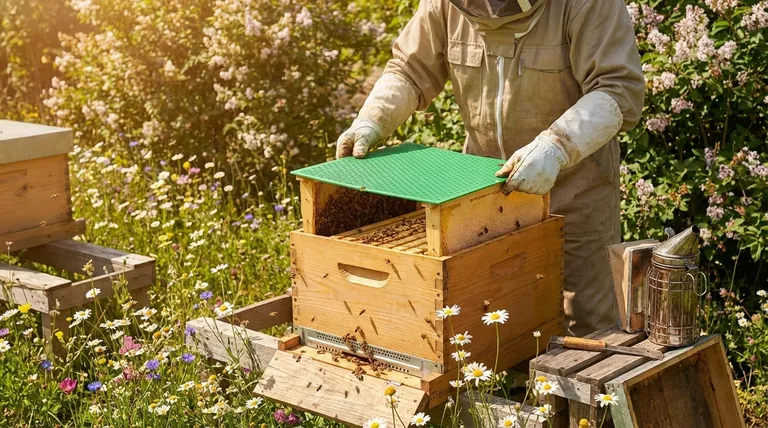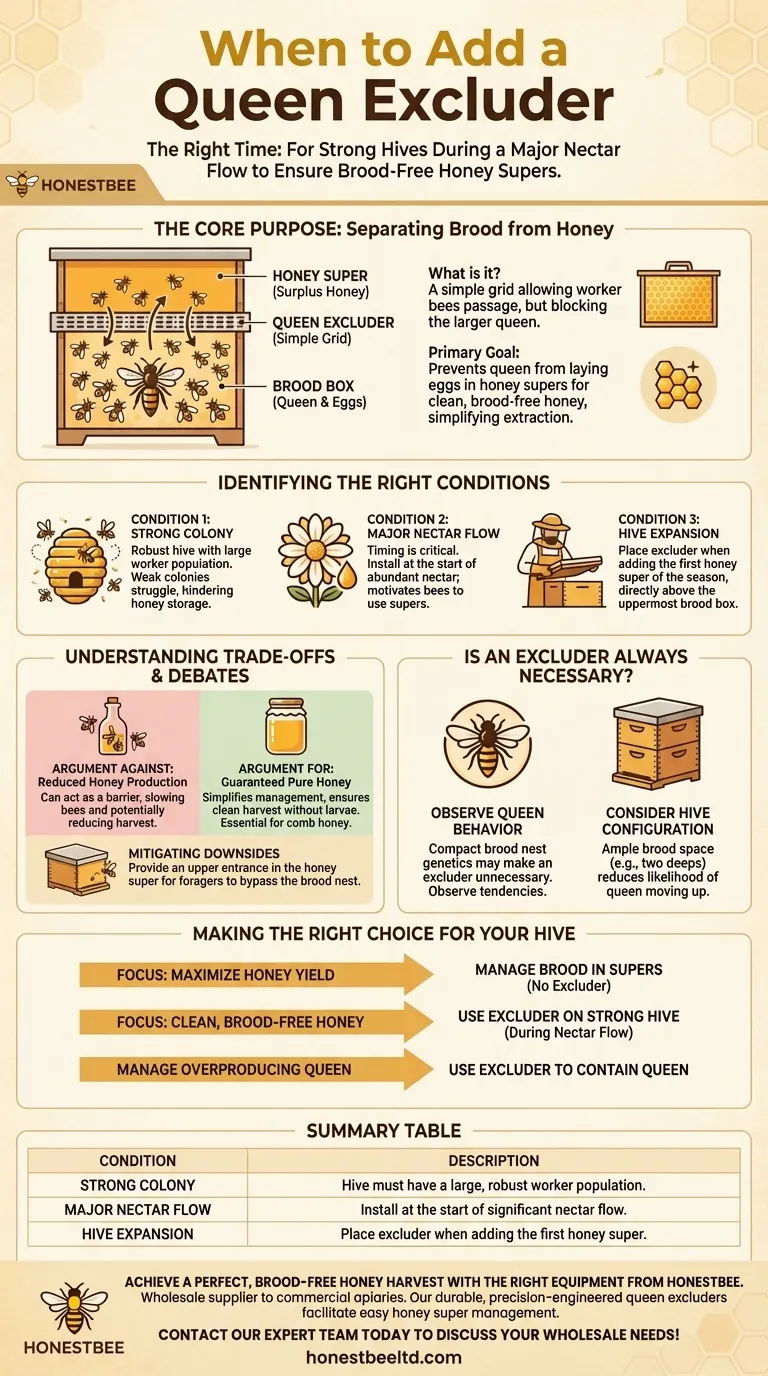The right time to add a queen excluder is when you are adding honey supers to a strong, well-established hive that is actively bringing in nectar during a major nectar flow. Its purpose is to confine the queen to the brood boxes, ensuring your honey supers remain free of eggs and larvae for a cleaner, easier harvest.
A queen excluder is a management tool, not a mandatory piece of equipment. Its use depends entirely on the strength of your colony, the timing of the nectar flow, and your personal goal of keeping the brood nest separate from your honey stores.

The Core Purpose: Separating Brood from Honey
What is a Queen Excluder?
A queen excluder is a simple grid or screen with openings large enough for worker bees to pass through but too small for the larger queen bee.
It is placed between the brood box (where the queen lays eggs) and the honey supers (where you want the bees to store surplus honey).
The Primary Goal: Brood-Free Honey Supers
The sole function of an excluder is to prevent the queen from laying eggs in the honey supers.
This is highly desirable because it ensures the honey you harvest is pure and free of developing bees. It simplifies the extraction process and prevents honey from taking on a darker color or different flavor from the brood.
Identifying the Right Conditions for Installation
Condition 1: A Strong, Thriving Colony
An excluder should only be placed on a robust hive with a large population of worker bees.
A weak colony will struggle to move past the barrier in sufficient numbers, potentially hindering their ability to store honey effectively. The hive must be strong enough to treat the supers above the excluder as a natural extension of their home.
Condition 2: A Major Nectar Flow
Timing is critical. The ideal moment to add the excluder is at the start of a significant nectar flow.
When nectar is abundant, the bees are highly motivated to find storage space. This strong natural drive encourages them to move through the excluder and begin working in the honey supers immediately.
Condition 3: Hive Expansion
The physical act of installing an excluder happens when you add your first honey super of the season.
The excluder is placed directly on top of the uppermost brood box, and the new honey super is then placed on top of the excluder.
Understanding the Trade-offs and Debates
The Argument Against: Reduced Honey Production
Many beekeepers believe an excluder acts as a barrier, slowing down worker bees as they travel between the brood nest and the honey supers.
This "bottleneck" can potentially reduce the efficiency of honey collection and storage, leading to a smaller harvest. It's often referred to as a "honey excluder" by those who oppose its use.
The Argument For: Guaranteed Pure Honey
Proponents value the absolute certainty that their honey supers will contain only honey. This simplifies management and guarantees a clean harvest without the complication of accidentally extracting larvae.
For beekeepers selling comb honey or aiming for the highest quality product, this separation is non-negotiable.
Mitigating the Downsides
You can reduce the traffic-jam effect of an excluder by providing an upper entrance for the bees.
A small entrance hole drilled in the honey super above the excluder allows foraging bees to fly directly into the storage area, bypassing the need to travel through the excluder and busy brood nest.
Is an Excluder Always Necessary?
Observe Your Queen's Behavior
The decision to use an excluder should be based on observation. Keep notes on your colony's tendencies.
Some bee genetics, particularly from locally bred queens, result in a tighter, more compact brood nest. These queens may have little desire to move up into the honey supers, making an excluder unnecessary.
Consider Your Hive Configuration
A colony with ample space in the brood boxes (e.g., two deep brood boxes) is less likely to become "honey bound," a condition where the queen runs out of laying space.
If the queen has plenty of room to lay, she is less likely to seek out space in the honey supers above.
Making the Right Choice for Your Hive
Making a decision requires balancing your goals with the specific behavior of your bees.
- If your primary focus is maximizing honey yield: You might choose to operate without an excluder and manage any brood that appears in the supers.
- If your primary focus is clean, brood-free honey for easy extraction: Using an excluder on a strong hive during a major nectar flow is the correct strategy.
- If you manage bees with a strong tendency to overproduce brood: An excluder can be an essential tool to contain the queen and encourage honey storage.
Ultimately, successful beekeeping comes from observing your specific colonies and using tools like the queen excluder to meet your objectives.
Summary Table:
| Condition | Description |
|---|---|
| Strong Colony | Hive must have a large, robust population of worker bees. |
| Major Nectar Flow | Install at the start of a significant, active nectar flow. |
| Hive Expansion | Place excluder when adding the first honey super of the season. |
Achieve a perfect, brood-free honey harvest with the right equipment from HONESTBEE.
As a wholesale supplier to commercial apiaries and distributors, we understand that maximizing honey purity and operational efficiency is critical to your business. Our durable, precision-engineered queen excluders are designed to facilitate easy honey super management without hindering your bees' productivity.
Let HONESTBEE equip your operation for success. Contact our expert team today to discuss your wholesale needs and discover how our beekeeping supplies can enhance your yield and simplify your harvest.
Visual Guide

Related Products
- High Performance Plastic Queen Excluder for Beekeeping and Apiary Management
- Professional Plastic Queen Excluder for Modern Beekeeping
- Premium Wood Framed Metal Wire Queen Bee Excluder
- Wooden Queen Bee Excluder for Beekeeping
- Plastic Queen Bee Excluder for Bee Hive Wholesale
People Also Ask
- What happens if I don't use a queen excluder? Understand the impact on your honey harvest.
- What materials are modern queen excluders made from? Choose the Right Material for Your Apiary
- Why don't all beekeepers use Queen Excluders? Balancing Honey Purity with Hive Productivity
- What impact does a queen excluder have on colony defensiveness? Control Hive Temperament for Safer Beekeeping
- When is the best time to place a queen excluder? Optimize Honey Production & Purity



















